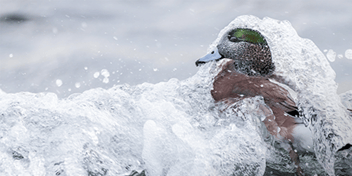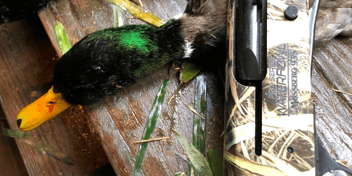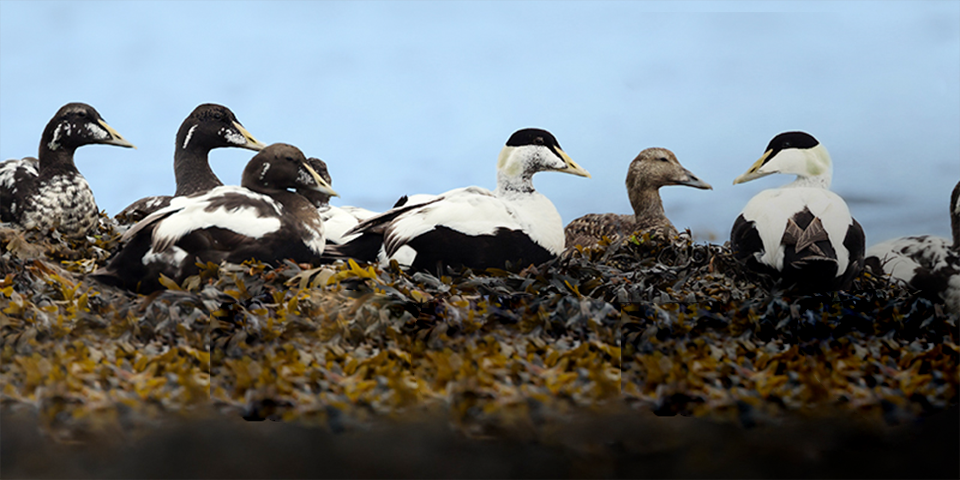
Nothing is harder on metal outdoors gear than the ocean. On a recent sea duck hunt in Maine, I asked my hunting buddies why they used wind spinner decoys instead of the motorized versions. Their answer was simply, "they don't last a day in the salt water."
It didn't take long to figure out that the extremely salty brine supports a wide diversity of life, but is extremely harsh on manmade devices with steel or moving parts. We made sure to drain the sea water from our outboard motors every day, as the saltwater can cause problems even in items made for marine conditions.
I used a Final Approach floating blind bag to store my shotshells in, as the brass bases on the hulls would start to rust if not protected. I was amazed to see some of our spent shotshells that had ejected into the ocean show extreme rust in just a couple hours. While collecting the empty hulls when picking up our decoys I quickly realized specialized gear was definitely necessary.
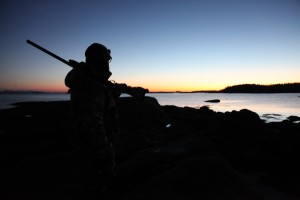 Scouting the water for eilers
Scouting the water for eilers
One of my biggest concerns was my shotgun. Shooting a semi-automatic, I know the risks of getting sand, crushed sea shells, and salt water in the action. It can bring the shooting to a grinding halt just when you least expect it. To make things even worse, El Nino was providing unseasonably warm temperatures, which had stalled the migration of eiders from the St. Lawrence Seaway and down the Atlantic coast from Newfoundland, New Brunswick, and Nova Scotia in Canada. With eiders being scarce it meant sitting for hours before we eventually had one of the largest ducks in North America cupping its wings and soaring into the decoys.
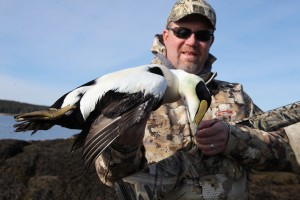 Brad Fenson with the eiler he took down during his hunting trip
Brad Fenson with the eiler he took down during his hunting trip
The first morning out we had waited over an hour after legal light before a single, adult male eider drifted over the end of the decoy string I was sitting on. My first shot rippled across the water behind the bird even though I'd been warned many times to increase my lead more than I thought I'd need. Fortunately, my second shot was right on target and folded the heavy bird with a thunderous splash into the Atlantic.
I was thrilled with my early success and spent the rest of the morning admiring the bird in hand. Everything about the eider is big, from the gland on its bill used for processing fresh water to the thick layer of down that lines their skin.
Evenings were spent telling stories about the change in eider migration over the years and how sea duck hunting was often hit or miss depending on migration and abundance of food supply, which is primarily small, developing blue mussels. Adult eiders eat 10 to 20 mussels a day and will dive to 80 feet in order to find them. Anyone that's an avid duck hunter would quickly get lost in the conversation and when I should have been cleaning my shotgun I was busy listening to the tall tales from around the dinner table.
The next morning was foggy, with a fine mist hanging in the air. Looking directly into the wind would coat my glasses in water in a matter of seconds. I knew the wet conditions would be challenging for my gun and after putting out three strings of decoys I took up my statue-like position on the rocky ledges on the small island we were hunting.
The wait was a lot shorter on day two and when a pair of eiders decoyed perfectly my shotgun put both on the surface of the ocean. The rain, fog, mist and sea spray hadn't slowed down the cycling of my 12 gauge in any way, shape or form.
My gun stayed operational because of the new coatings and metals used by Mossberg on their new 930 Pro Series semi-automatic 12 gauge shotgun. For a matter of fact, I didn't clean or do any maintenance after the second day of hunting either and the shotgun fired over 40 rounds to help me collect a few more of the unique ducks along the Atlantic coastline.
The Mossberg model 930 Pro Series has a synthetic stock, making it resistant to the salt and sea spray. Special coatings on metal components ensure proper cycling and prevent rust from forming. Boron nitride coating on the gas piston, piston rings, magazine tube, and hammer, sear, return spring plunger and return spring tube prevent rust and deterioration of working and moving parts. The shell stop, bolt slide and elevator have extra finishing to reduce friction when cycling. It offers interchangeable chokes and a Stock Drop System that provides a drop-at-comb adjustment shims to adjust the fit and feel. The 930 Pro Series is available in Mossy Oak Shadowgrass Blades.
By Brad Fenson

